Facing lawsuit, Illinois county removes Ten Commandments monument from courthouse
Jefferson County’s Christian monument sparked outrage, a lawsuit, and, ultimately, a legal retreat
This newsletter is free and goes out to over 22,000 subscribers, but it’s only able to sustain itself due to the support I receive from a small percentage of regular readers. Would you please consider becoming one of those supporters? You can use the button below to subscribe or use my usual Patreon page!
A Ten Commandments monument outside the Jefferson County Courthouse in central Illinois will be coming down after a coalition of church/state separation groups filed a lawsuit demanding as much. (I first wrote about this over a month ago but I’m republishing it here with important updates.)
The saga began nearly a year ago when the Decalogue was installed right inside the front entrance. It was over six feet tall, mostly granite, and included at its base a biblical quotation from Proverbs 21:15: “When justice is done, it is a joy to the righteous but terror to the evildoers.”
There were a lot of glaring problems with the monument. For example, why reference the Bible chapter that also includes, just a few verses later, “Better to live in a desert than with a quarrelsome and nagging wife”? And why use that simplified form of the list, given that the KJV version of the Ten Commandments are actually very specific about what you’re not supposed to covet, like cattle and your neighbor’s wife? And even if the commandments were meant to aligned horizontally (so #3 and #8 were directly across from each other), didn’t it just look awkward?!
More importantly, why put it up at all? It’s not like this monument went up decades earlier and people just noticed it now. It was brand new, completely unnecessary, and blatantly illegal. You can’t have a stand-alone Christian monument on government property, much less one that promotes one particular version of the religion.
No recent Supreme Court ruling has ever overturned the 2005 decisions regarding these kinds of monuments in government spaces. One, involving a display at the Texas Capitol, said such monuments were legal as part of a larger secular context. The other, involving a Kentucky courthouse, said stand-alone Ten Commandments displays were illegal. This situation was virtually identical to that latter case.
Speaking with a local newspaper, Jefferson County Sheriff Jeff Bullard explained that he was allowed to erect this monument because of the SCOTUS ruling in Kennedy v. Bremerton… the case about the showboating high school football coach who demanded the right to pray at midfield after games. But nothing about that case seemed to apply here.
That decision established that the Lemon Test—which helped judges determine if a law violated church/state separation—was essentially dead… but the Lemon Test didn’t create church/state separation. It merely offered a way to test it. Without that test, there were plenty of other tools judges could use to determine if a government action went too far. And this monument was obviously about government promotion of religion.
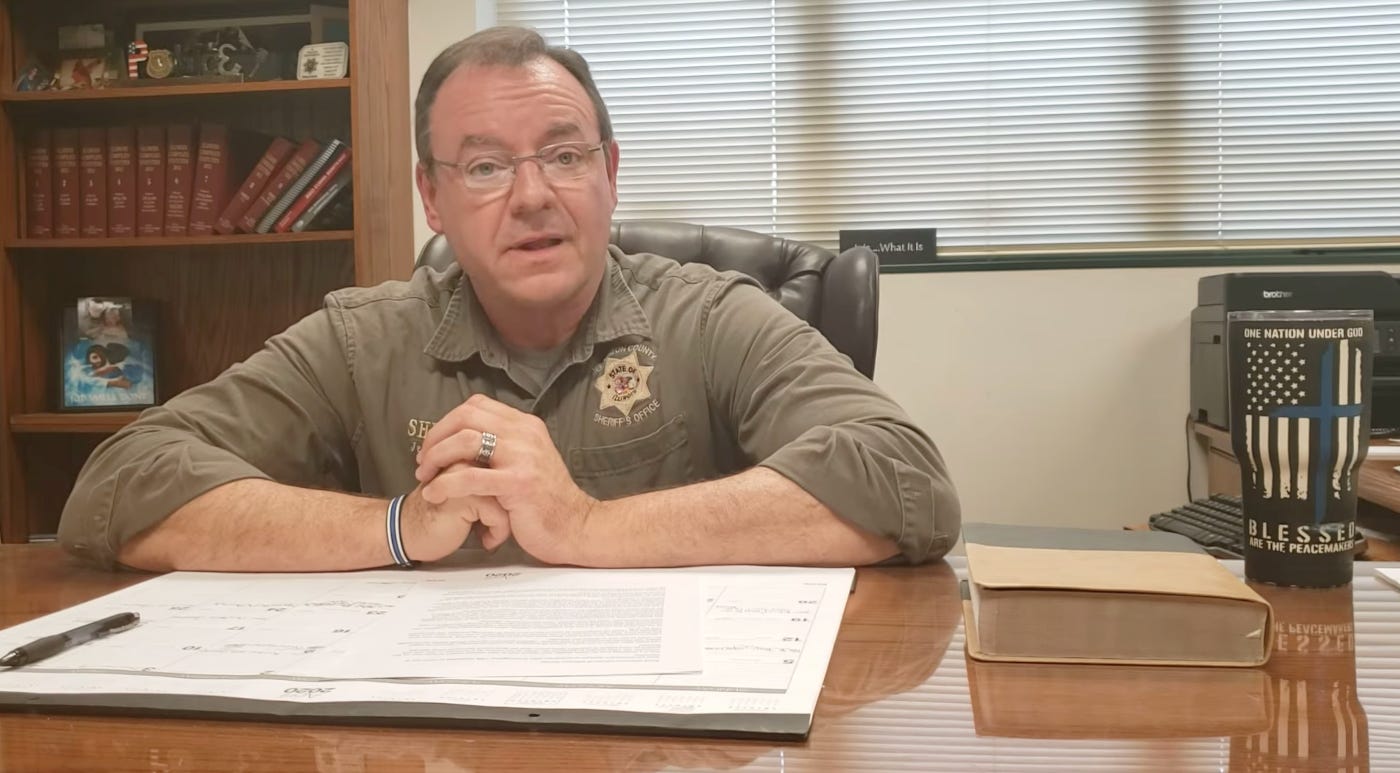
In a letter to the county board at the time, in addition to making all those points, Freedom From Religion Foundation legal fellow Hirsh M. Joshi pointed out that this monument was brand new, which knocked out the only plausible defense for keeping it there.
… the monument is not part of Jefferson County’s longstanding history, because the monument was erected less than a week ago. This does not come close to the so-called “history and tradition test” which was discussed in Kennedy. Even within a historical framework, there is no historic authority providing that the Establishment Clause permits a county government to adopt and give preference to particular religious commandments.
Making matters worse for the county, the sheriff never publicized or announced the installation of the monument in advance. Much like Christian sex predator Roy Moore did in Alabama in 2001, Bullard just had it erected without telling anyone but his closest allies he was doing it—or who was paying for it.
It was only after it was installed that we learned those details:
… in March of 2024, a group of several interested Jefferson County churches and private individuals came forward to provide the financial support needed to have the monument placed at the local courthouse, Bullard said.
“The project was completed and delivered by Pyramid Marble and Granite out of Effingham, Illinois,” Bullard said. “They, along with Daniel Heck of Rick’s Towing, did an outstanding job of creating and installing it, which took place Friday morning, Aug. 23.”
A private ceremony unveiling the new monument took place on Sunday, Aug. 25. During the ceremony, all of the donors were thanked for their contributions.
“I thank everyone who supported and encouraged this project to restore a piece of our heritage and history in Jefferson County,” Bullard said.
The monument had nothing to do with the county’s heritage or history. And as many critics of similar monuments have noted, the display sent a very clear message that the Christian book of rules—and a very specific brand of Christianity at that—overrode the Constitution and state laws. The implication was that non-Christians would not receive a fair shake in the county courthouse because they didn’t follow those rules. (Most of the Commandments, of course, are completely detached from secular law. The government should not care if you don’t keep the Sabbath day holy or don’t respect your parents.)
This was nothing more than a symbol of religious intolerance and exclusion.
In any case, the County never responded to FFRF’s letter.
In the months to follow, Bullard must have spoken to lawyers who told him this was a bad idea… so he made a few changes. He covered up the Bible verse at the base of the monument and moved the whole thing outside to the courthouse lawn.
That obviously didn’t fix the main problem because… it was still the Ten Commandments on courthouse property.
That’s why FFRF, the ACLU of Illinois, and the ACLU (national) sued the Jefferson County Board of Commissioners. In their filing with a state circuit court, they include several details that were extremely damning for Bullard and the Commissioners who didn’t stop him.
For example, the lawsuit said Bullard “used official government resources, channels, and personnel to promote, finance, and install the Monument.”
For example, Bullard circulated a “Donation Pledge Form” to several potential donors, which stated that solicited donations “go to the Jefferson County Sheriff’s Office Ten Commandments project for 2024.”
Sheriff Bullard directed donors to make checks out to the “JCSO Chaplaincy Division,” to be deposited into the government account for the Jefferson County Sheriff’s Office’s Chaplaincy Division, and to mail the checks directly to the Sheriff’s Office. He instructed donors to drop off physical checks at the Sheriff’s Office.
He raised over $10,000 that way, covering the total cost of the monument. Some of the cash ($1,000) came directly from the Jefferson County Sheriff’s Office Chaplains.
Another problem: When Bullard spoke with the companies constructing the monument, he didn’t do it in a private capacity, instead signing his messages as “sheriff.”
The people who gave money knew exactly why they were doing this—and it sure as hell wasn’t for any secular reason.
For example, in a letter to Sheriff Bullard accompanying a $500 donation, one church wrote: “We are thankful to have a sheriff who not only has Biblical beliefs but is also willing to stand for those beliefs in a great way. Our prayer is that this will not only serves as a symbol for what God’s standard for living is, but that this will also serve as a missions opportunity to point people to the saving knowledge of Jesus Christ.”
The lawsuit also noted that Bullard’s office knew this might be a problem. His deputy sheriff wrote in an email to employees that, if asked about the source of the monument, they should say it’s “paid for through donations,” adding that “The Supreme Court overturned the separation of church and state.” (That wasn’t true, even if the conservatives on SCOTUS have done everything in their power to weaken it.)
On the weekend the monument was installed, a memo urged employees to keep the public out of sight: “Do not let people gather around when delivered.”
When Bullard invited donors to celebrate the monument’s installation, he also told everyone to keep it private: “No news or social media.” Then he got on-duty cops to make sure only invited guests could attend the ceremony.
Things got even more bizarre after Bullard realized the monument in the building could pose serious legal problems. The lawsuit said he spoke to attorneys from First Liberty Institute who told him the monument needed to be moved outside—which is a weird suggestion since that wouldn’t resolve the myriad legal issues—but that relocation cost the county $5,250. Since he only had a few hundred dollars left over from the donations, he plucked the remainder ($4,868) from the County’s “Chirper Fund”… which was a public fund meant to help prisoners communicate with their loved ones.
During all this time, Bullard wasn’t just acting alone. The County Commissioners didn’t do anything to take down the monument. In fact, when they consulted County Attorney Sean Featherstun, he was, well, stunned.
Featherstun advised that he had consulted four lawyers, all of whom indicated that the Monument raised serious legal concerns, with the best advice from them being, “Hope you’re insured.” Featherstun expressed frustration that he was not consulted before the Monument was erected and noted that his “analysis doesn’t change” based on the Monument being moved…
…
Featherstun identified several factors that could weigh against the Monument’s legality, noting that “[a]n inconspicuous monument appears safer than a large prominent one” and that having “religious donors” undermines the argument that the monument is “non-religious”… He also noted that “[t]aken by themselves, the symbolism of the Ten Commandments is largely understood to be religious.…”
Despite his concerns, the board members voted to retain the monument on the courthouse lawn. One of them, the lawsuit claimed, even said he was “willing to roll the dice” because the Board “gets sued all the time.”
Not every lawsuit has merit, but this one very obviously did.
The Plaintiffs were several Jefferson County residents, including a Christian pastor, who didn’t believe the display belonged at the courthouse. (The pastor said “the Monument demeans and trivializes a holy text by turning it into a lawn decoration.” Another Plaintiff, who’s Catholic, objected to the version of the Commandments being used since it doesn’t line up with his beliefs and the version that is being used has been used in the past “to condemn Catholic religious practice.”)
“With the lawsuit, Jefferson County taxpayers are standing up for the fundamental constitutional principle that the government must remain neutral when it comes to matters of faith,” notes Freedom From Religion Foundation Co-President Annie Laurie Gaylor. “Erecting a Ten Commandments monument on public property, whether in the courthouse lobby or just outside the entryway, blatantly violates Illinois law.”
…
“In Illinois, we do not permit local politicians to use the power and authority of their office to promote their religious views,” adds Kevin Fee, legal director for the ACLU of Illinois. “Our organization has always worked to ensure that everyone’s religious freedom is respected. This monument — which must be removed immediately — attempts to undermine that freedom for many residents. We are pleased to represent these clients in seeking fairness in Jefferson County.”
Heather L. Weaver, senior counsel for the American Civil Liberties Union, says: “The separation of church and state guarantees that we all have the right to decide, for ourselves, which religious beliefs, if any, people should follow. By sending the message that Jefferson County favors some faiths over others, the Ten Commandments monument intrudes on deeply personal matters. We’ll see Jefferson County in court.”
Even if the sheriff and the County Board did everything by the book and pretended this was all about honoring our nation’s past, they would have had an uphill climb trying to convince a judge this was a purely secular display. But when you look at what they actually said and did, and where the money came from, and all the ways they tried to hide their true religious intentions, there was just no getting around how these people used public money—and their government roles—to promote Christianity.
And now, within two months, there’s a resolution to all this.
When the Board of Commissioners met shortly after the lawsuit was filed, they voted 7-3 to remove the monument from the courthouse lawn. While that’s the right move, it seemed unusual coming from the right-leaning board. But an article in the Morning Sentinel (paywalled but you can read it here) said that “the county’s insurance company, CIRMA, recently denied the county’s claim to be defended in the lawsuit.”
In other words, the insurers knew this was a losing cause and they said as much right away. If the county wanted to fight this battle, they would lose, and taxpayers would have been on the hook for the costs.
Board Chair Clifford Lindemann said on Facebook that the costs could have been as high as $5 million (according to the insurers)… while implying that groups like FFRF and the ACLU bully boards like theirs into submission:
Sheriff Jeff Bullard, the guy behind all this, directly blamed the insurers: “I did not realize in my planning that there was a loophole in the county’s insurance policy.” (There’s no loophole. Insurers deny claims all the time, especially when they’re this blatantly pointless.) He added that he was “confident that we would prevail before the U.S. Supreme Court, [but] there is a possibility we would lose in the lower courts and then the High Court [could] refuse to hear our case on appeal,” which would result in massive legal fees. That’s why capitulating was the only rational option.
The good news is that the monument was moved to West Salem Trinity Church with private funds. That’s where it should’ve been from the beginning. This is a religious monument and it belongs at a religious facility, not inside or outside a courthouse.
There was, however, an open question of whether the lawsuit would be over. Was the removal enough to end the case?
On Tuesday, after the Board promised the monument would never return to County property, both sides agreed to dismiss the case.
The Plaintiffs were thrilled with the outcome:
“We’re happy that the county eventually complied with Illinois’ church-state guarantees,” says Hirsh M. Joshi, Patrick O’Reiley Legal Fellow at the Freedom From Religion Foundation. “It was an honor to help my fellow Illinoisans keep their local government secular.”
“We’re delighted that after we sued, the county acted with alacrity to remove these biblical edicts from the seat of county government,” adds FFRF Co-President Annie Laurie Gaylor. “This action shows that Jefferson County understands it has no right to tell residents which gods to worship, how many gods to worship or whether to worship any gods at all.”
Kevin Fee, legal director for the ACLU of Illinois, noted the role that local residents played in the victory: “Our clients showed great courage in coming together and challenging this illegal action by their local elected officials. It is easy to be silent and not speak up. But these brave residents stood up for constitutional values and demanded change.”
Daniel Mach, director of the ACLU’s Program on Freedom of Religion and Belief, applauded the county’s decision: “This is a victory for religious freedom. Although county officials had no business prominently displaying biblical scripture at the seat of local government, we’re glad that they’ve now fixed their constitutional error.”
All of this could have been avoided if the sheriff or Board members listened to their attorney instead of their Christian base. It took a lawsuit from secular groups to force them to do the right thing because nothing about their faith taught them how to be responsible public officials. It’s the right outcome. It just shouldn’t have taken a lawsuit for these Board members to see the light.
(Portions of this article were published earlier)

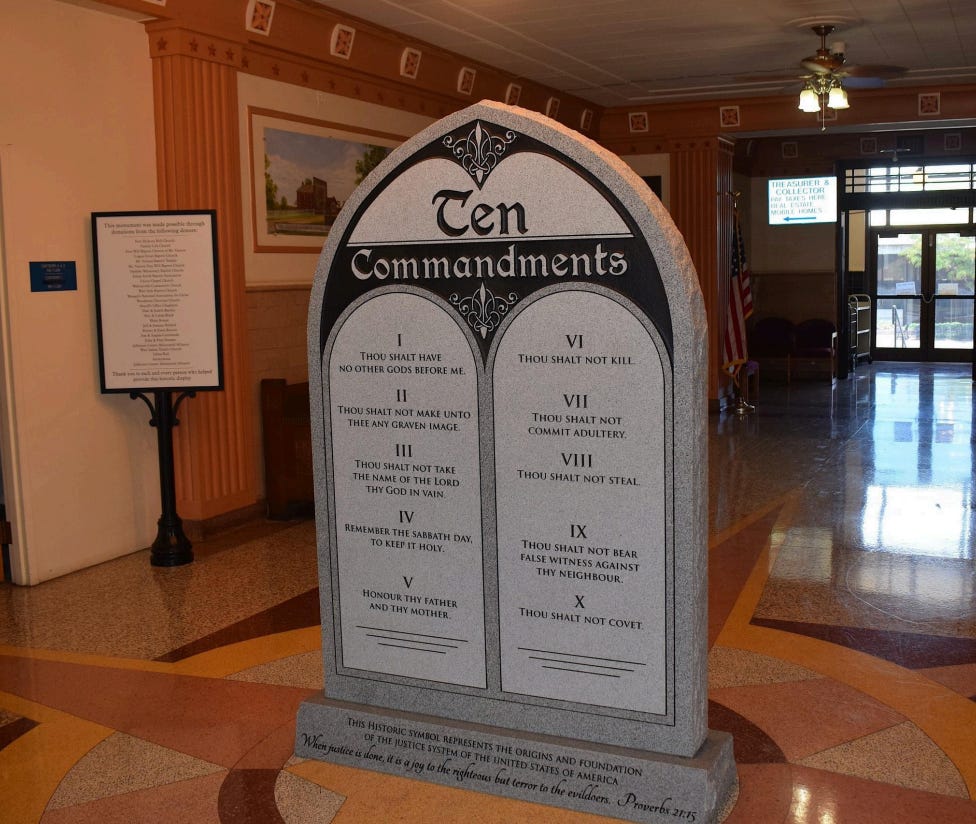
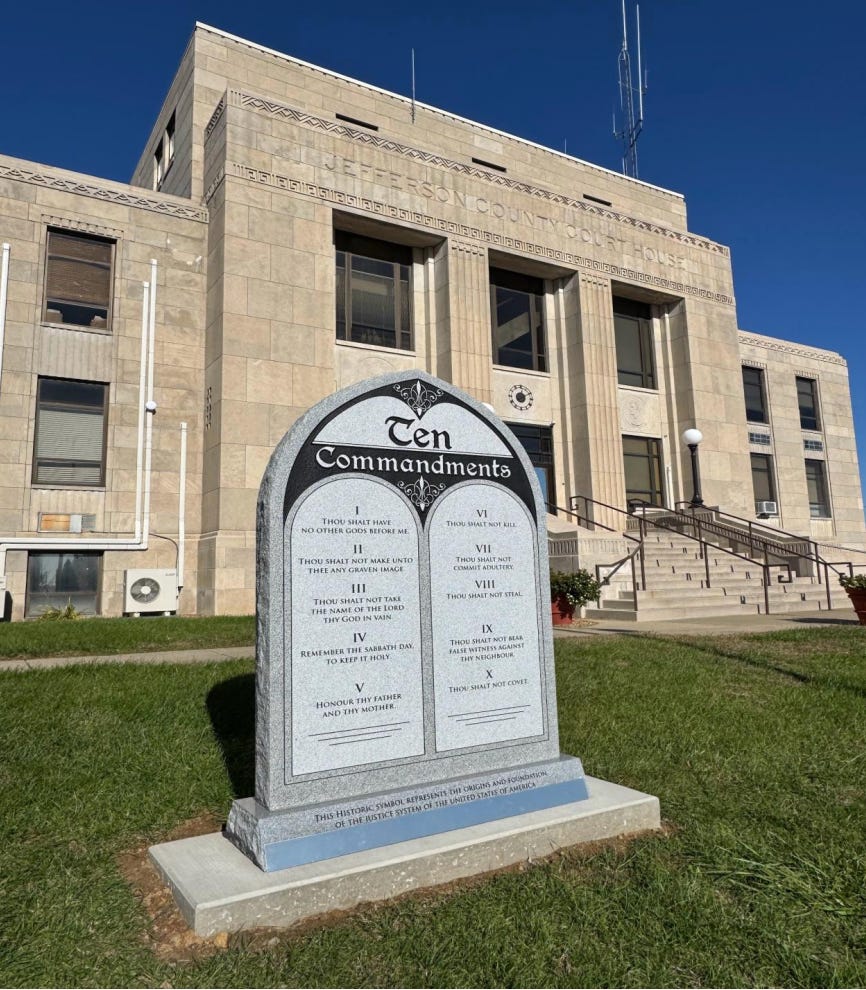
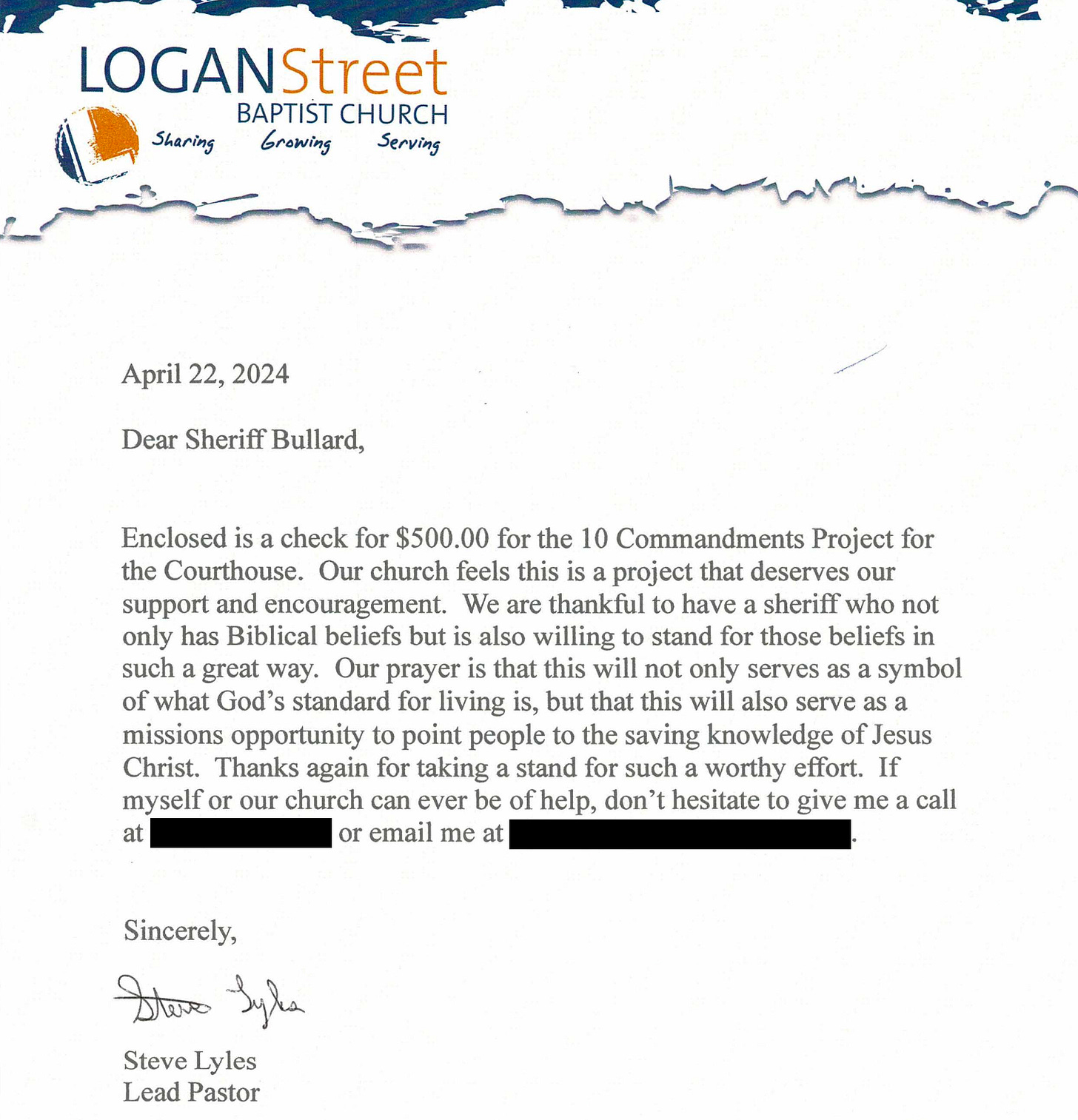
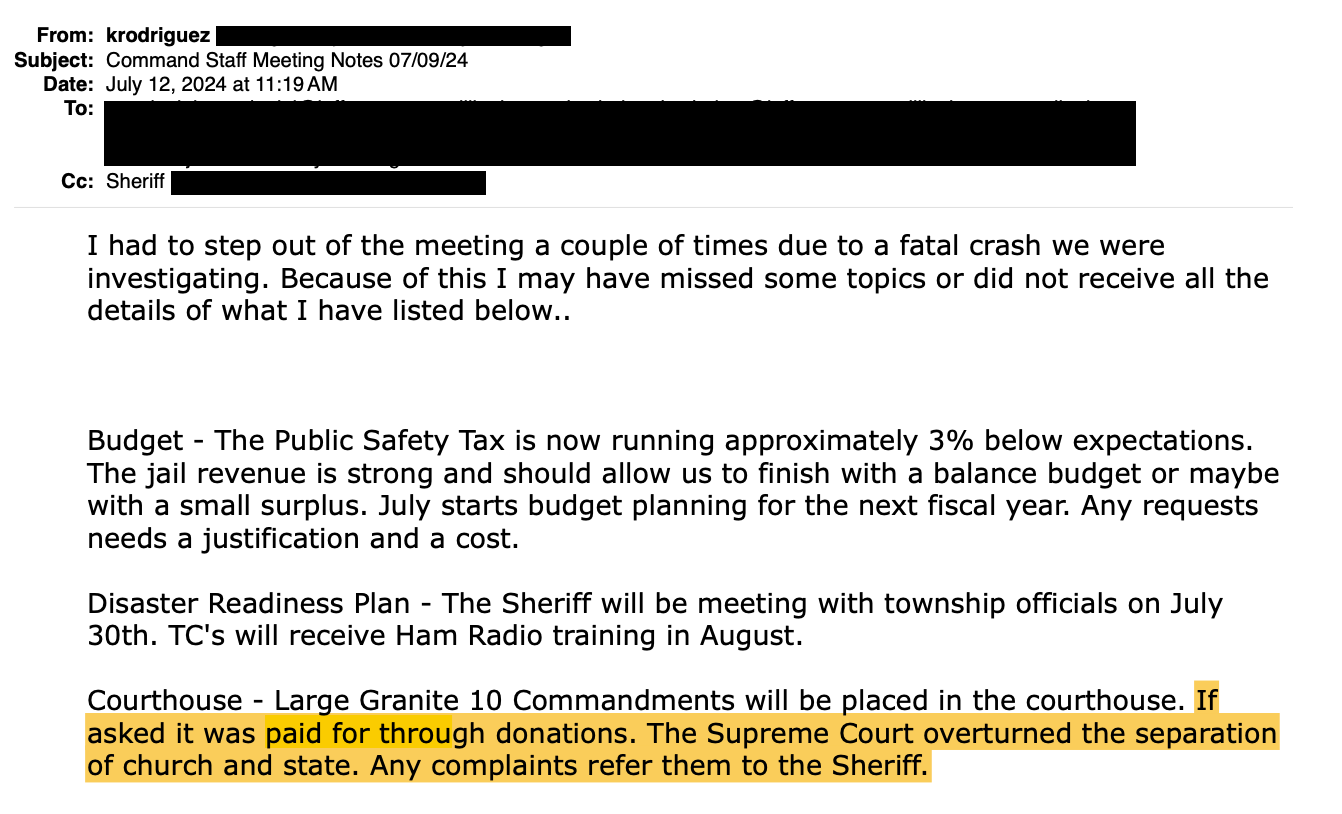
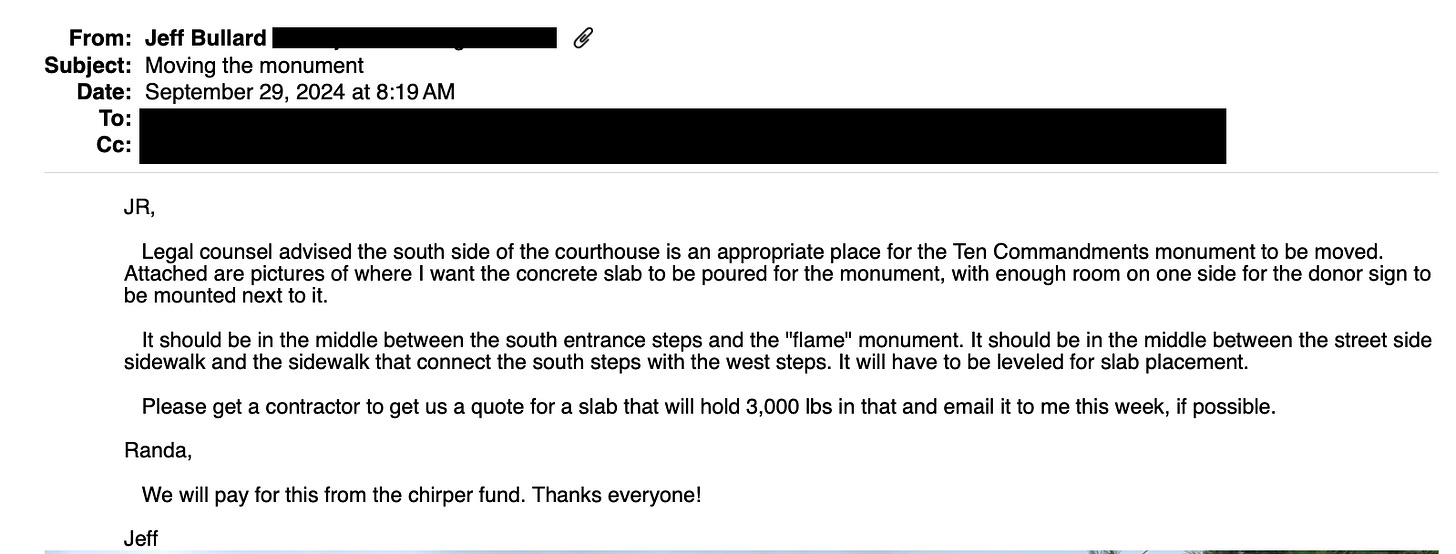
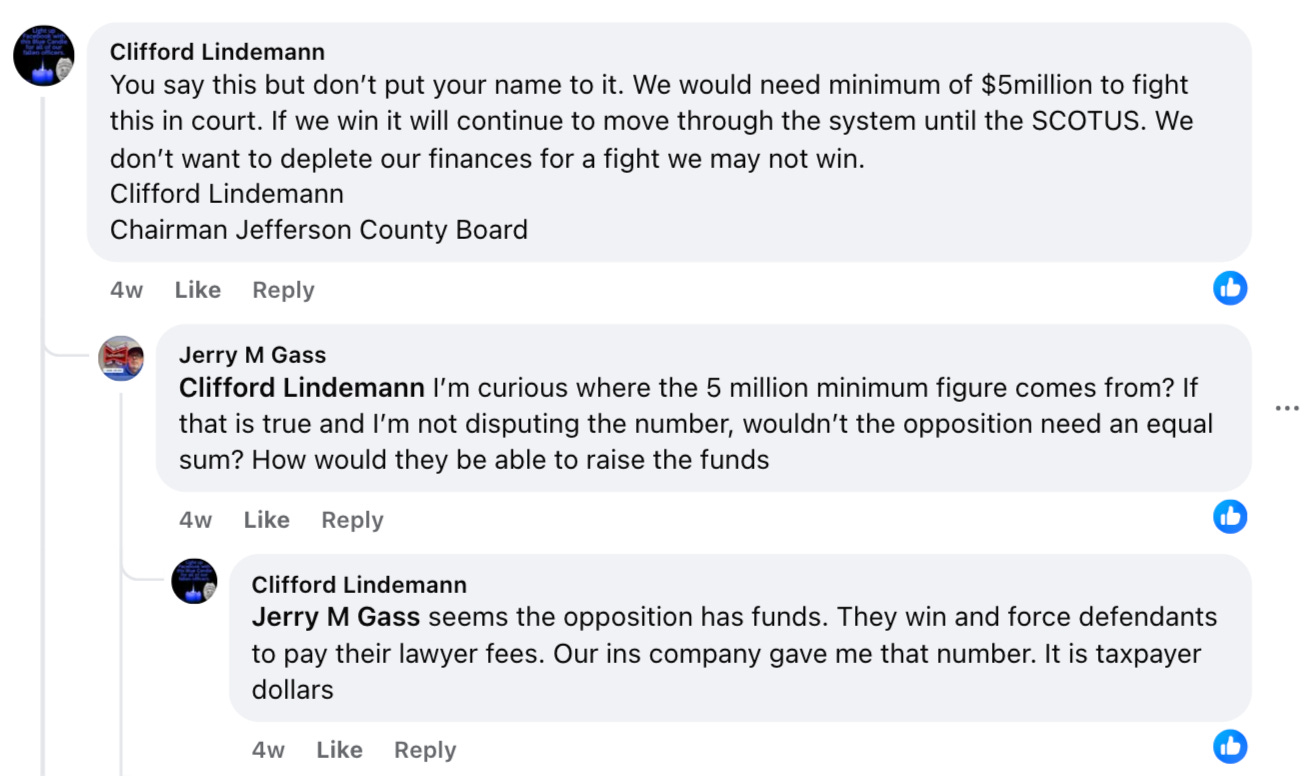
Two remaining questions:
- Did the sheriff pay back the $4,868 stolen from the County’s “Chirper Fund" ?
- Will he be punished for this theft ?
It isn't as if these monuments to the Ten Commandments are actually going to result in better people, because there is zero evidence to support that idea. It's also ironic that they be stationed in a court house given the fact eight of the Commandments would be unconstitutional should anyone try writing them into law. This is just more performance art on the part of the religious right. They either get to mark their territory in the public square, or they get to play the poor, persecuted victims of the godless left.